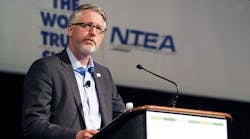INDIANAPOLIS. As green and other technologies continue to evolve in the trucking world, truck outfitters have a growing challenge to get everything a fleet needs together and make it work. Because truck outfitters work with a wide cross section of fleets, they are positioned to see the latest trends in trucking.
“There have been a lot of changes to work trucks in recent years, which has been mentioned many times,” said Chris Weiss, vice president of engineering at the Knapheide Manufacturing Company. Among those changes are alternative fuels, hybrid, electric plug-in, light weighting, connectivity, and more.
Weiss spoke during the Green Truck Summit at the opening of NTEA's Work Truck Show at the Indiana Convention Center. His company, Knapheide, is a Quincy, IL-based truck body manufacturer.
“As an outfitter, though, we see certain trends,” he added. “One of those, as we look at the type of upfits, are customers are using more types of vehicles… Retail vehicles are fair game for commercial applications and the number of types of vehicles are continuing to grow.”
“Customers are also trying to do a lot more with less vehicle,” Weiss said. “We see a big trend in smaller vehicles being used – that could a downsizing of trucks from a Class 3 to a Class 2.”
The move to smaller vehicles in the commercial sector could be for fuel economy, acquisition costs, to meet DOT requirements, among other reasons, Weiss said.
“As an upfitter, we continue to be challenged to optimize the space and payload available in those vehicles,” he said.
Green technologies in trucking continue to evolve in types and popularity, according to Weiss. “The work truck industry, if you saw in the past couple of years, took off with CNG and propane (autogas).”
Now more in trucking are turning to electrification, light-weighting and other growing technologies, he said. With that, upfits are getting more complicated. “We’re trying to fit more into a single vehicle overall,” Weiss said. “That means maximizing use.”
Fleet needs, Weiss said, “play a large factor in the green technologies that are developed.”
Green technologies that work cut down costs, he said. “Even as you’re trading off different technologies, the cost is always a primary consideration for a fleet. And that could be acquisition costs, it could be fuel or energy costs, maintenance, residual value.”
In the end, Weiss said, fleets are looking for a good return on investment. “They are looking for payback in the end,” he said.
“I always like to say, ‘It’s great to have a green technology vehicle but in the end, the fleet customer has to do work with that truck, they have to do the same amount of work with that vehicle as they did with the non-green technology.”
A lot of fleets also have vehicle preferences, such as brand, vehicle type, model, equipment and more. Along with these preferences, Weiss said, more fleets are looking for one-stop shopping when it comes to upfitting.
“So as you get more complicated and you’re adding technologies in there, it’s much easier to go to one source to pull it all together,” he said. “That could be doing the actual alternative energy conversion on the vehicle as well as integrating the work that’s on top. So it’s a turn-key solution they’re looking for.”
“In many ways, we’re the consultants,” Weiss said. “We’re deriving specifications to try and help that fleet customer pull things together. We are that one-stop-shop solution.”
Because of all the factors involved in upfitting, Weiss said that sometimes vehicles can’t be done the original way a fleet wants it done. “So we have to provide design trade-offs and alternatives to get to the best solution for the customer.”
As a technology integrator, upfitters such as Knapheide have to add in alternative fuels and electrification, connectivity, lightweight materials, and more.
“Although we are not experts in all of these, we have to be that knowledge center of vehicle standards, non-vehicle standards, quality standards and the technologies,” Weiss said.




